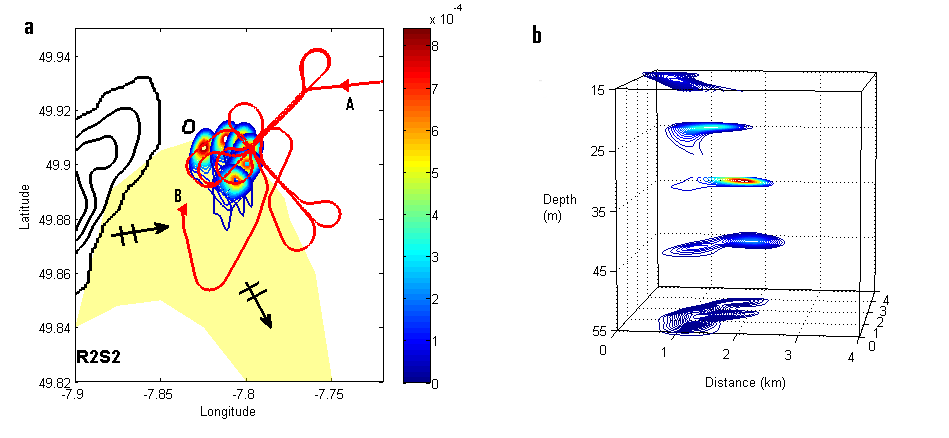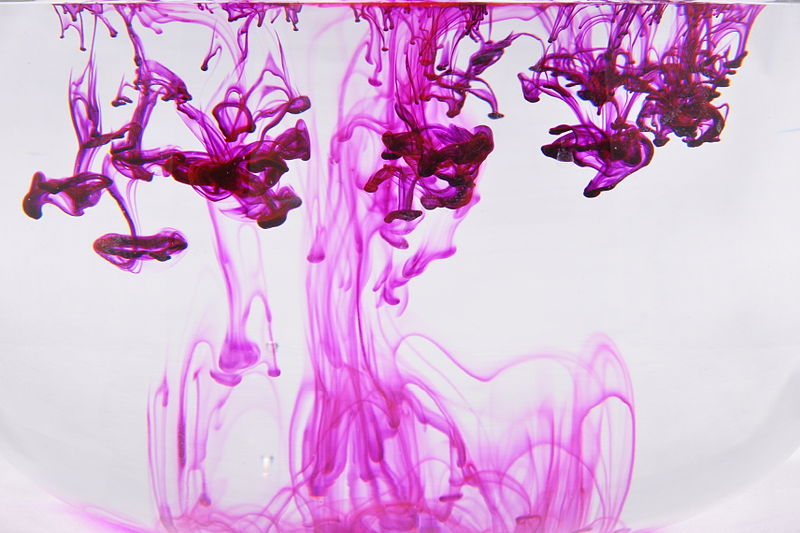story by Helen Hill

Getting a detailed instantaneous picture of the interior state of the ocean remains the consuming challenge of observational oceanography. This month we focus on newly published work by seasoned MITgcm modelers Nataliya Stashchuk and Vasiliy Vlasenko (University of Plymouth, UK) and Mark Inall and Dmitry Aleynik (Scottish Marine Institute Oban, UK). Stashchuk et al have been assessing whether high resolution MITgcm tracer simulations can help “connect the dots” in the sparse sampling problem associated with observing the evolution of released dye in a shallow sea.
In their paper “Horizontal dispersion in shelf seas: High resolution modeling as an aid to sparse sampling”, now online at Progress in Oceanography, the team use MITgcm to investigate the ability of a hydrodynamic model to reproduce the results of a dye release experiment conducted in a wide shelf sea environment.
In the associated field experiment in the Celtic Sea a fluorescent tracer, Rhodamine WT, was injected into the seasonal pycnocline, and its evolution tracked for two days using a towed undulating vehicle equipped with a fluorometer and a CTD.

(a) Six successive contours of the model tracer taken with one hour time interval at the depth of 35 m overlaid with the Scanfish track. The ship track is shown by the red line. Letters A and B show the beginning and the end of the survey, respectively. (b) Horizontal distribution of the tracer at different depths taken in the end of the survey. Yellow zone with arrows shows the area and direction of propagation of the strongest internal wave systems generated by tides” – excerpted from Fig. 7 Stashcheck et al. (2014)
Having been able to quite accurately replicate evolution of the dye patch, the team then went on to explore specific mechanisms responsible for increased horizontal dispersion. In particular they report finding that enhancement of the dye dispersion was controlled by vertically sheared currents that, in combination with vertical diapycnal mixing, led to a substantial increase in the “effective” horizontal mixing.
In particular they determined that values of “effective” horizontal mixing found from the model runs agreed well with those obtained from in-situ data, leading them to conclude that “an accurate application of numerical models of the type used (here) has a great potential for estimations of the water mixing in general, and in dye release experiments in particular.”
To find out more about this work contact Nataliya

Nataliya Stashchuk (right) (here pictured on the Great Wall in China with long time collaborator Vasiliy Vlasenko (left)) started working with the MITgcm in 2006. Since then the pair have published 15 papers on oceanic internal waves, baroclinic tides, strait and plume dynamics, deep-water circulation. When not MITgcming Stashchuk likes to travel a lot, play tennis, or draw pictures
This Month’s Featured Publication
- Stashchuk, N., V. Vlasenko, M.E. Inall, and D. Aleynik (2014), Horizontal dispersion in shelf seas: High resolution modelling as an aid to sparse sampling, Progress in Oceanograph, Available online 28 August 2014, doi: 10.1016/j.pocean.2014.08.007
All publications co-authored by Vlasenko and Stachchuk using MITgcm
Other New Publications this Month
Demange, J., L. Debreu, P. Marchesiello, F. Lemarié, and E. Blayo (2014), Numerical representation of internal waves propagation,
ISSN 0249-6399 ISRN INRIA/RR–8590–FR+ENG RESEARCH REPORT N° 8590, August 2014, Project-Team MOISE pdf
Ferreira, D., J. Marshall, P.A. O’Gorman, and S. Seager (2014), Climate at High Obliquity, In Press at Icarus, doi: 10.1016/j.icarus.2014.09.015
Gibson, T., F. Hohman, T. Morrison, S. Reckinger, and S. Reckinger (2014), Experimental and Numerical Studies of Oceanic Overflow, Bulletin of the American Physical Society, 67th Annual Meeting of the APS Division of Fluid Dynamics , Volume 59, November 23–25, 2014; San Francisco, California link
Ilıcak, M. (2014), Energetics and mixing efficiency of lock-exchange flow, Ocean Modelling, Available online 28 August, 2014, doi: 10.1016/j.ocemod.2014.08.003
Kim, Sung Yong, G. Gopalakrishnan, A. Ponte (2014), Interpretation of coastal wind transfer functions with momentum balances derived from idealized numerical model simulations, Ocean Dynamics, September 2014, doi: 10.1007/s10236-014-0766-x
Marshall, J., J.R. Scott, K.C. Armour, J.-M. Campin, M. Kelley and A. Romanou (2014), The ocean’s role in the transient response of climate to abrupt greenhouse gas forcing, Climate Dynamics, Observational, Theoretical and Computational Research on the Climate System, doi: 10.1007/s00382-014-2308-0
Marques, GM. and T.M. Özgökmen (2014), On modeling turbulent exchange in buoyancy-driven fronts, Ocean Modelling, available online 6 September 2014, doi: 10.1016/j.ocemod.2014.08.006
Sciascia, R., C. Cenedese, D. Nicolì, P. Heimbach and F. Straneo (2014), Impact of periodic intermediary flows on submarine melting of a Greenland glacier, Journal of Geophysical Reseach
– Oceans, accepted, doi: 10.1002/2014JC009953
Soerensen, A.L.., R.P. Mason, P.H. Balcom, D. J. Jacob, Y. Zhang, J. Kuss, and E.M. Sunderland (2014), Elemental Mercury Concentrations and Fluxes in the Tropical Atmosphere and Ocean, Environ. Sci. Technol., Article ASAP, doi: 10.1021/es503109p, Publication Date (Web): August 29, 2014
Stashchuk, N., V. Vlasenko, M. E. Inall, and D. Aleynik (2014), Horizontal dispersion in shelf seas: High resolution modelling as an aid to sparse sampling, Progress in Oceanograph, Available online 28 August 2014, doi: 10.1016/j.pocean.2014.08.007
Vitousek, S. and O.B. Fringer (2014), A nonhydrostatic, isopycnal-coordinate ocean model for internal waves, Ocean Modelling, available online 6 September 2014, doi: 10.1016/j.ocemod.2014.08.008
Wahib, M. and N. Maruyama (2014), Scalable Kernel Fusion for Memory-Bound GPU Applications, SC14
Do you have news about research using MITgcm? We are looking for contributions to these pages. If you have an interesting MITgcm project (ocean, atmosphere, sea-ice, physics, biology or otherwise) that you want to tell people about, get in touch. To make a post, contact Helen

